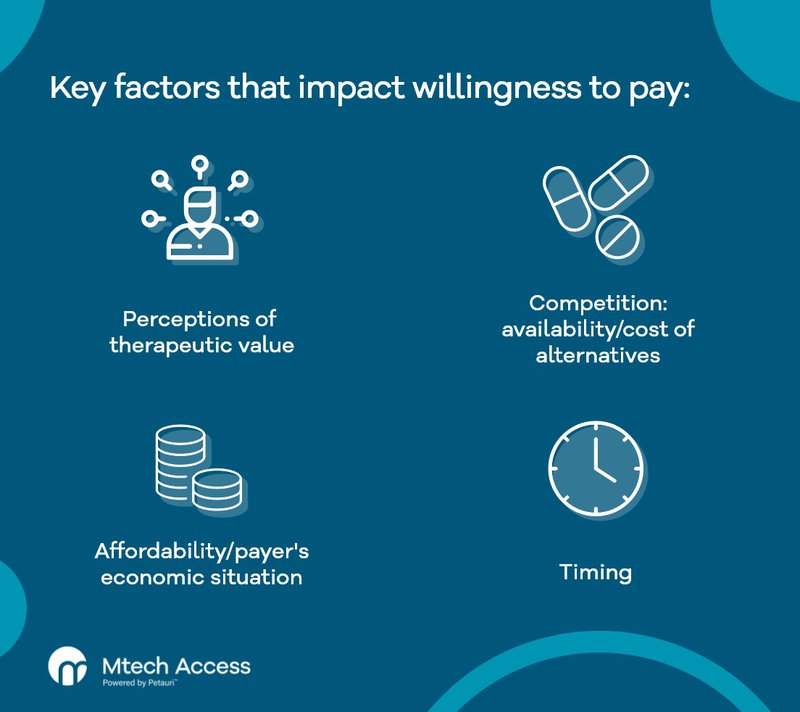
Heather Wellam (Senior Consultant – Market Access, Mtech Access) explores the concept of willingness to pay (WTP) and what it means for pharmaceutical and medtech pricing strategy. Read on to explore 4 factors that impact WTP and compare 5 methodologies for price testing with payers and other key stakeholders.
What is WTP?
WTP is a concept founded in behavioural economics, which is defined as the maximum price a consumer is willing to pay for a product or service. In the healthcare arena, the product could be a medicine, medical device, or health service, and the consumer could be a commissioner, payer, healthcare professional, or patient, depending on the structure of the healthcare system and the decision-making context.
4 factors that impact WTP in healthcare
WTP is often expressed as a threshold or price range. Several factors can influence a consumer’s WTP. For instance, perceptions of therapeutic value, the availability of alternatives, and economic conditions can all impact how much someone is willing to pay. Additionally, WTP can vary over time.

1) Perceptions of therapeutic value
A payer’s WTP can be influenced by the unique attributes that a product offers, such as improved efficacy, safety, or formulation. Additionally, how innovative the product appears compared with existing options, as well as the severity of the unmet need it addresses can also affect WTP.
2) Competition: availability/cost of alternatives
WTP reflects market demand. In a crowded market, consumers are less likely to pay a premium. However, in a market with few alternatives, consumers may show a higher WTP due to the limited options available.
3) Affordability/payer’s economic situation
WTP is closely tied to affordability. For a healthcare system, the price of a product must be economically justified and sustainable. A patient’s WTP can be influenced by factors such as age, income, gender, employment status, and other demographic considerations.
4) Timing
WTP is not static and can change over time. Variations in healthcare system budgets, shifts in the competitive landscape as biosimilar/generic products enter the market, patent expirations, or the emergence of new evidence can all impact WTP.
Why is WTP an important concept for pharma and medtech?
WTP can help to inform and define an appropriate pricing strategy. If you set prices too high, valuable sales can be missed; set prices too low, and revenue is lost. Therefore, having a good understanding of WTP can help a pharmaceutical company or medtech manufacturer make intelligence-led decisions.
5 methods for testing drug pricing and determining WTP
Researchers have developed various methods to evaluate WTP, each with its own advantages and limitations. Careful research design is required to select and implement the most appropriate technique. Here, we explore 5 methodologies for researching and analysing WTP in a healthcare setting:
- Monadic
- Gabor–Granger
- Van Westendorp/price sensitivity/perceived value
- Conjoint analysis
- Brand price trade-off
All methodologies involve questioning a group of key stakeholders about a product's potential pricing. These stakeholders will typically include payers, clinicians, patients, and health technology assessment (HTA) agencies.
1) Monadic
What is Monadic price testing?
Monadic price testing is a method used to assess how different price points affect a product’s likelihood of being reimbursed or prescribed. In this approach, a portion of the respondent sample are shown the product at one price, while another are shown the product at a different price. By comparing these two (or more) sub-samples, researchers can determine how price influences decision-making.
Advantages
One of the key advantages of Monadic price testing is the low risk of bias. As respondents are only exposed to one price, they are not aware that the study is evaluating price, which ensures results are more reliable.
Limitations
Monadic price testing requires a large sample size, making it both costly and time consuming. Additionally, if the sample demographics are not well-matched, this can introduce uncertainty into the results, potentially affecting the accuracy of the findings.
2) Gabor–Granger
What is the Gabor–Granger method?
Gabor–Granger is a variant of monadic price testing. In this approach, respondents are shown a series of different price levels for a product, one at a time, and asked how likely they would be to approve or prescribe the product at each price. The results are then used to create a demand curve, which shows the percentage of the sample that would approve the product at each price point.
Advantages
The Gabor–Granger method is straightforward to conduct, making it both time efficient and cost effective. Unlike Monadic, it doesn’t require perfectly matched sample demographics, reducing the complexity of the study design.
Limitations
As respondents know that they are participating in a pricing study, they may become more price sensitive than if it was a real-world scenario, potentially skewing the results. Additionally, the highest price presented and the order of prices can influence the outcomes, so these factors must be carefully chosen and interpreted.
3) Van Westendorp/price sensitivity/perceived value methodology
What is the Van Westendorp method?
The Van Westendorp method is a pricing technique that focuses on how respondents perceive a product’s value at different price levels. In this approach, participants are asked to indicate price points that they associate with various perceptions of value: prohibitively expensive, expensive, inexpensive, and so inexpensive that it raises doubts about quality. This information helps to identify the range of prices that align with the perceived value of the product.
Advantages
The Van Westendorp method is straightforward to conduct and provides valuable insights by assessing a range of price levels rather than simply testing just one. This can be particularly useful during the early stages of product development, when only a draft target product profile is available, or when there is not a clear comparator.
Limitations
Similarly to Gabor–Granger, respondents know that they are participating in a pricing study, which may artificially increase their sensitivity to price. Additionally, the concept of ‘expensive’ as perceived by respondents does not always directly translate to actual reimbursement or prescribing behaviours.
4) Conjoint analysis
What is conjoint analysis?
Conjoint analysis is a method used to understand how different product attributes, including price, impact the preferences of key stakeholders. In this approach, respondents review various combinations of product features and prices, and then express their preferences. By analysing these preferences, researchers can determine the relative importance of each attribute to the respondents.
Advantages
One of the main benefits of conjoint analysis is that it evaluates price alongside other product attributes. This provides a more comprehensive view of how various factors influence payer decision-making.
Limitations
One of the limitations is that it assumes that price is a relevant factor in the decision-making process and that payers and other stakeholders consider attributes rationally. This may not always reflect real life decision-making, where other factors, such as regulatory constraints and clinical outcomes, can have a greater impact on payer decisions.
5) Brand price trade-off
What is the brand price trade-off methodology?
The brand price trade-off methodology is a technique used to evaluate how price influences product choice in a competitive market. With this approach, respondents are shown the prices of competing products alongside the lowest price of the product being tested. They are then asked to choose which product they would prescribe. If the test product is chosen, its price is increased, and the process is repeated until respondents opt for one of the competing products.
Advantages
This method provides valuable insights by assessing price in the context of the competitive landscape. It also allows researchers to evaluate choices among multiple products, offering a clear picture of how price affects decision-making in relation to competitors.
Limitations
As prices are introduced sequentially, respondents may become desensitised to price changes over time. Additionally, the method involves various factors, making the analysis complex and challenging.
Support with price testing and analysis
If you're looking to optimise your pricing strategy and ensure your product's success in the market, Mtech Access are here to help. We specialise in price testing and analysis with payers across key global markets. Our experts will select the most effective price testing methodology for your needs. Whether you're exploring the impact of different pricing models or assessing reimbursement likelihood, our experienced team can provide the insights and support needed to make informed decisions.
Contact us today at info@mtechaccess.co.uk to discover how we can assist you in finding the right pricing strategy for your product.
Check out this case study outlining how we supported a client who wanted to understand how pricing and market dynamics were impacting the uptake of their product in France, Germany, Italy, Spain, and the UK.



